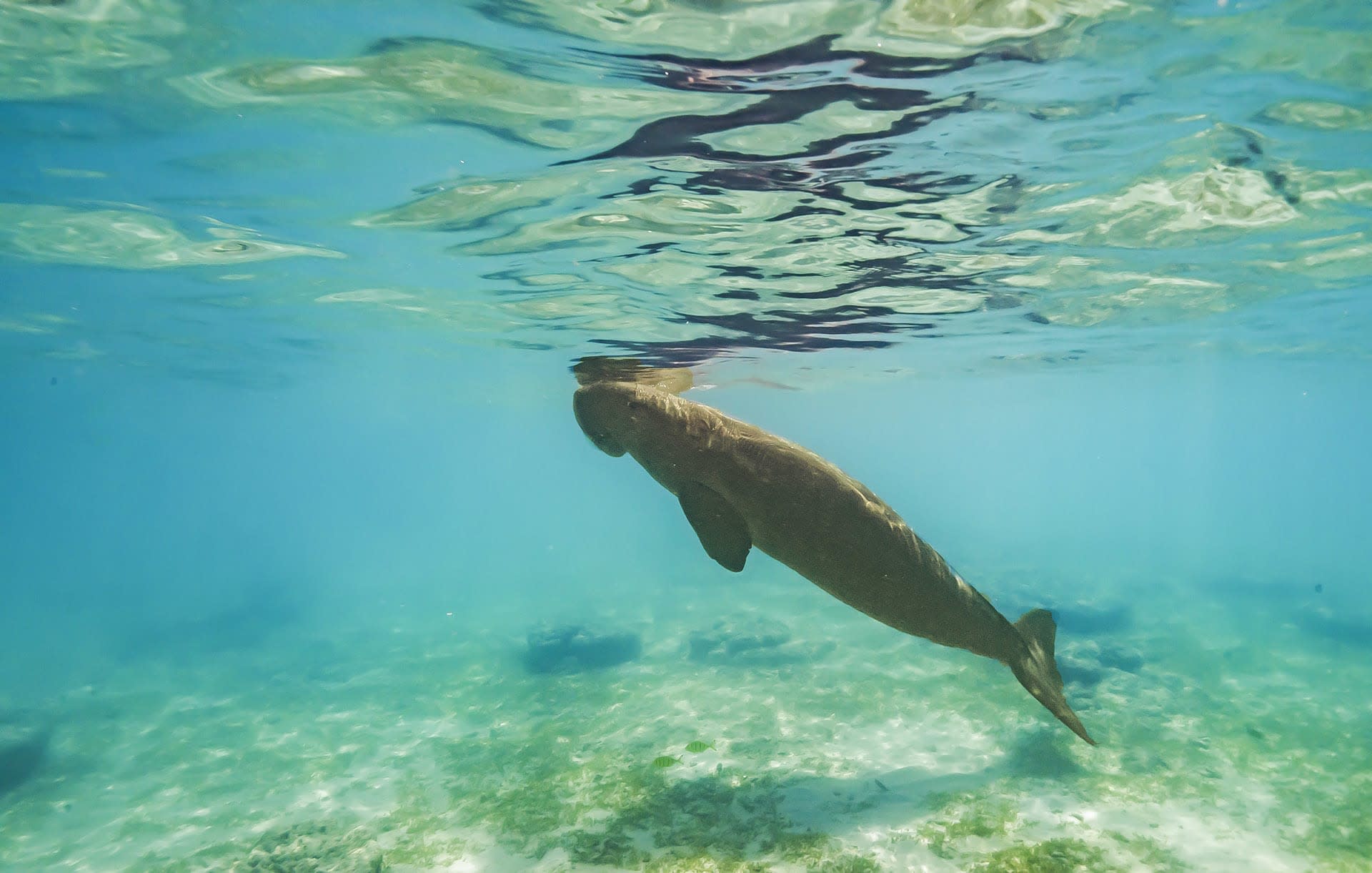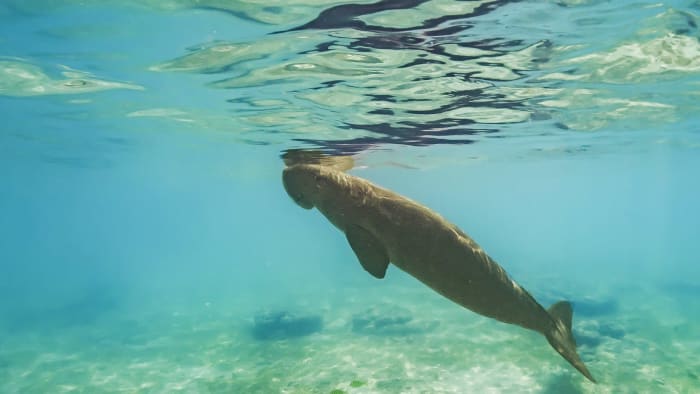 Listen to this article
•
15:34 min
Listen to this article
•
15:34 min
Tucked away in the Bay of Bengal, over 1,000 kilometres from India’s east coast, is the Andaman and Nicobar archipelago. Myanmar in the north and Indonesia in the south are the nearest neighbours. These emerald islands have dense forests, surrounded by shallow turquoise waters that house coral reefs, seagrass meadows, and mangrove forests. The reefs, seagrasses, and mangroves are home to diverse flora and fauna, some found only in this region. These waters are also one of the last pristine habitats in India that “sea cows” or dugongs (Dugong dugon) inhabit.
Until the early 2000s, no research had been carried out on dugongs in India; hence, our references or guidelines to initiate a study on this animal were based solely on findings from decades of dugong research in Australian waters. Our initial stints in the Andaman and Nicobar archipelago led us to understand the animal’s rarity as only a few younger fishermen had seen dugongs out at sea. In contrast, almost every inhabitant in the older age groups had seen and consumed the animal’s meat. Interactions with these fishermen and regular seafarers directed us to two small islands of the Richie’s archipelago where the chances of sighting a dugong were high. It is not easy to see a dugong in the often turbid waters of the archipelago, and studying one in the wild is nearly impossible. But we knew that dugongs spend most of their time feeding in seagrass meadows, leaving behind distinct serpentine trails, and we thought this was possibly the only way to study a rare and elusive animal like the dugong.

Cover photo: A dugong surfaces to breathe near Shaheed Dweep, an island in the Andaman archipelago. Photo: Dhritiman Mukherjee
First sighting
I remember that day in 2007 when our team of four were snorkelling in a seagrass meadow, watching the feeding trails of dugongs 8 m below us. We were so engrossed in these trails cutting through the mat of leaf-shaped seagrasses that we did not notice the one responsible for creating these. When we raised our heads above the water to speak, I noticed a huge, brown creature surfacing for air behind my colleague. Having only seen photographs of one, we were nervous about being so close to it. Our initial fear soon drowned as we watched the gentle animal focused on feeding, and least interested in us. That day we swam with “Alpha” for almost seven hours and for many more in the days and months that followed. In that same year, we encountered two more dugongs, only one being comfortable with our presence. Given their shy nature and the fact that very few animals continue to survive in all three regions of the Indian waters (Andaman and Nicobar archipelago, Gulf of Mannar and Palk Bay, and Gulf of Kutch), every sighting is a rare opportunity. Therefore, we used these chance encounters (and the only ones over the next 15 years that followed) to learn more about the animals, and made behavioural observations on which most of our future research hinged.

Picky feeders
There are 12 species of seagrasses found in the Andaman and Nicobar archipelago. Yet, the dugongs feed primarily on four of the most tender and nutritious varieties, completely uprooting them with their strong muzzles and leaving behind cleared, meandering trails. When these seagrasses are scarce, dugongs travel in search of newer meadows with these same species or, occasionally, bite off the tops of thicker, fibrous seagrasses that are generally not “preferred”.
Dugongs use a cluster of seagrass meadows not too far from each other. Since only a few animals use each of these clusters in the Andaman and Nicobar archipelago, the feeding pressure is low, and seagrasses recover from feeding bouts in less than ten days. Through their continuous feeding, dugongs “maintain” meadows with their “preferred” seagrasses. In the absence of their feeding, seagrasses age, lowering their nutritional value, and in some cases, are outcompeted by “less preferred” seagrasses.
In other parts of the world (like Australia and the Arabian Gulf), dugongs are found in large herds, with hundreds of animals in each herd. While feeding, these large herds almost completely clear out a meadow, abandon it for another lush meadow, and return after months when the seagrass has regrown.
Presently, dugongs continue to feed in less than half the total number of seagrass meadows known around the archipelago. These are the ones with their favourite food, and are large in size, unfragmented, and easy accessibility during rising and retreating tides. In half of these meadows, anthropogenic threats to dugongs and their habitats are high. Gillnets that drown dugongs surfacing for air, propellors of high-speed tourist boats that “slice” unaware dugongs, terrestrial sediments, and agricultural/sewage runoff that smothers the tender seagrass shoots either directly or indirectly by nurturing epiphytic algae are some of the noticeable dangers. On the one hand, the persistent dugongs can be easy targets and perish to these site-specific threats. On the other, they could thrive through active, concerted conservation efforts by the now well-informed managers and regular users of these seascapes.

Critical numbers
There are possibly less than 50 dugongs left in the waters of the Andaman and Nicobar archipelago. Through our informant network and personal sightings, we recorded only 20 live animals over ten years. There is the possibility of more animals that we missed in these counts. Nevertheless, this is still a dangerously low number for the continued survival of a population of slow-breeding animals. It may be decades before this population crosses the danger mark to a safe zone for existence. This crossover is possible only if hunting stops at all costs, boat speeds are reduced around feeding dugongs, nets are removed from feeding areas, and terrestrial runoff is checked and treated. The survival of dugongs now lies solely in the hands of the islanders, who must choose to be custodians of their environment and not mere spectators of ongoing development.








